Accounting for Business: Concepts & Financial Report Analysis
VerifiedAdded on 2023/06/18
|6
|1345
|162
Report
AI Summary
This report provides a comprehensive overview of accounting concepts used in the preparation of financial statements, including the business entity concept, money measurement concept, dual aspect concept, going concern concept, and cost concept. It further assesses the qualitative characteristics of financial reports, such as understandability, relevance, reliability, comparability, timeliness, verifiability, and consistency, highlighting their importance in making financial information useful for both internal and external users. The report emphasizes the significance of adhering to these concepts and characteristics to ensure accurate, reliable, and easily understandable financial reporting, thereby facilitating informed decision-making.
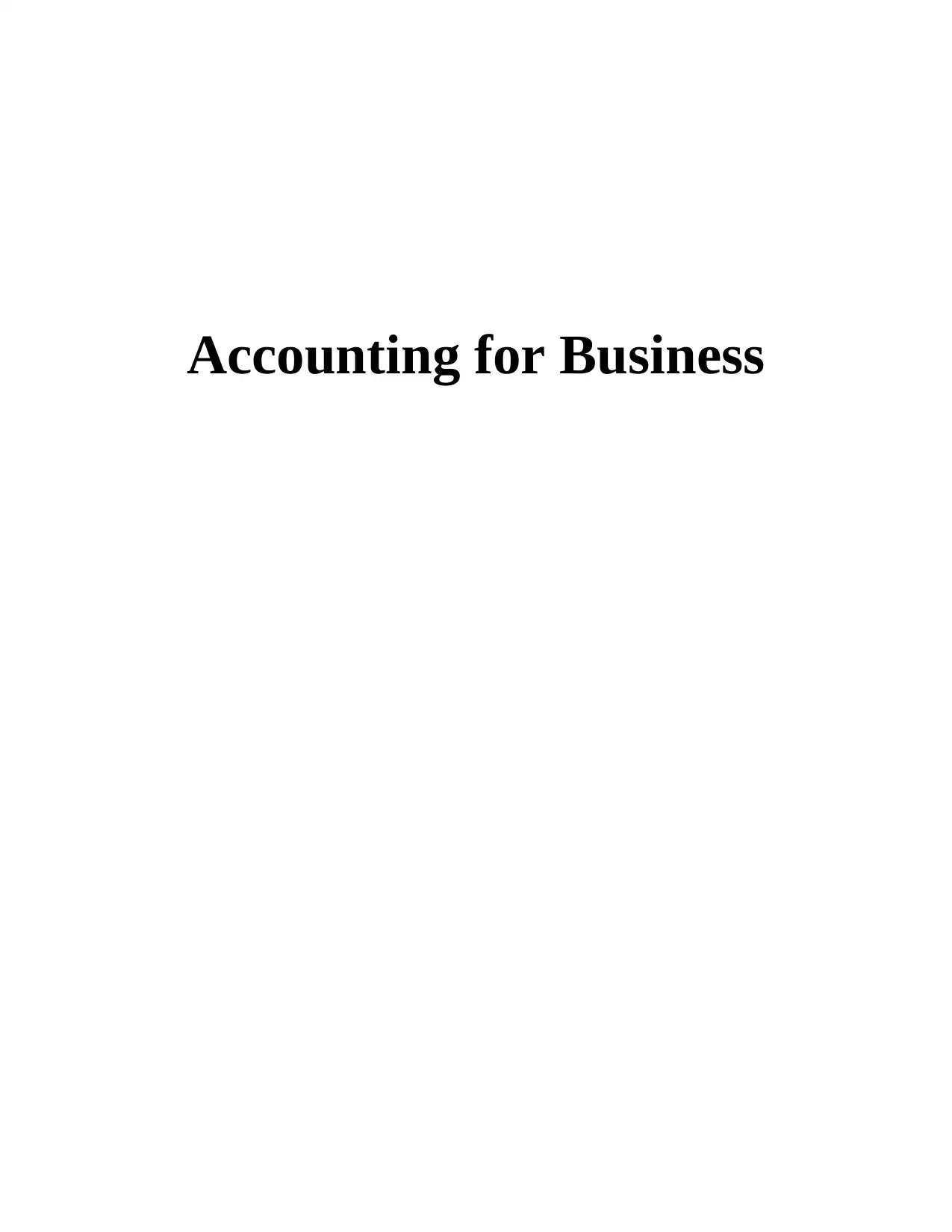
Accounting for Business
Paraphrase This Document
Need a fresh take? Get an instant paraphrase of this document with our AI Paraphraser
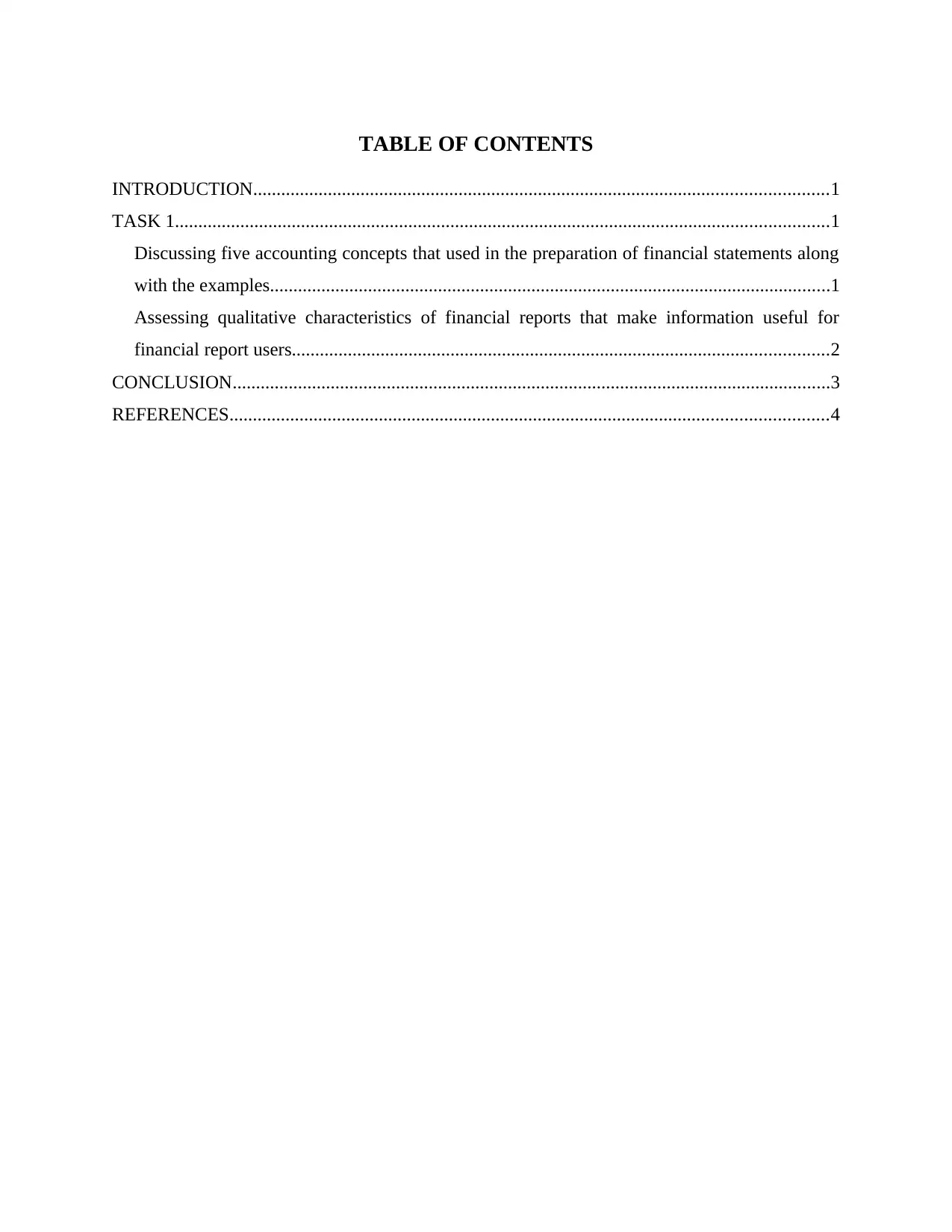
TABLE OF CONTENTS
INTRODUCTION...........................................................................................................................1
TASK 1............................................................................................................................................1
Discussing five accounting concepts that used in the preparation of financial statements along
with the examples........................................................................................................................1
Assessing qualitative characteristics of financial reports that make information useful for
financial report users...................................................................................................................2
CONCLUSION................................................................................................................................3
REFERENCES................................................................................................................................4
INTRODUCTION...........................................................................................................................1
TASK 1............................................................................................................................................1
Discussing five accounting concepts that used in the preparation of financial statements along
with the examples........................................................................................................................1
Assessing qualitative characteristics of financial reports that make information useful for
financial report users...................................................................................................................2
CONCLUSION................................................................................................................................3
REFERENCES................................................................................................................................4
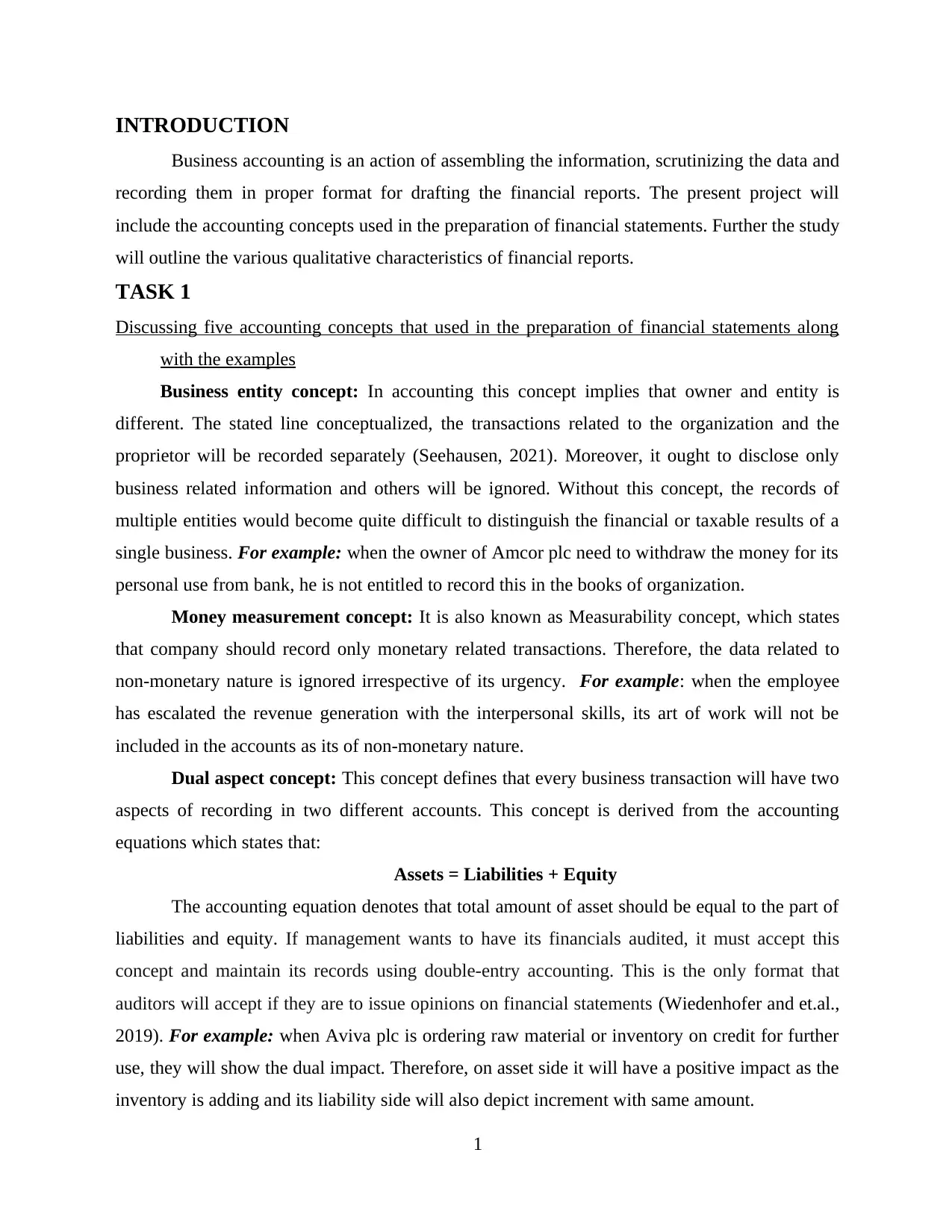
INTRODUCTION
Business accounting is an action of assembling the information, scrutinizing the data and
recording them in proper format for drafting the financial reports. The present project will
include the accounting concepts used in the preparation of financial statements. Further the study
will outline the various qualitative characteristics of financial reports.
TASK 1
Discussing five accounting concepts that used in the preparation of financial statements along
with the examples
Business entity concept: In accounting this concept implies that owner and entity is
different. The stated line conceptualized, the transactions related to the organization and the
proprietor will be recorded separately (Seehausen, 2021). Moreover, it ought to disclose only
business related information and others will be ignored. Without this concept, the records of
multiple entities would become quite difficult to distinguish the financial or taxable results of a
single business. For example: when the owner of Amcor plc need to withdraw the money for its
personal use from bank, he is not entitled to record this in the books of organization.
Money measurement concept: It is also known as Measurability concept, which states
that company should record only monetary related transactions. Therefore, the data related to
non-monetary nature is ignored irrespective of its urgency. For example: when the employee
has escalated the revenue generation with the interpersonal skills, its art of work will not be
included in the accounts as its of non-monetary nature.
Dual aspect concept: This concept defines that every business transaction will have two
aspects of recording in two different accounts. This concept is derived from the accounting
equations which states that:
Assets = Liabilities + Equity
The accounting equation denotes that total amount of asset should be equal to the part of
liabilities and equity. If management wants to have its financials audited, it must accept this
concept and maintain its records using double-entry accounting. This is the only format that
auditors will accept if they are to issue opinions on financial statements (Wiedenhofer and et.al.,
2019). For example: when Aviva plc is ordering raw material or inventory on credit for further
use, they will show the dual impact. Therefore, on asset side it will have a positive impact as the
inventory is adding and its liability side will also depict increment with same amount.
1
Business accounting is an action of assembling the information, scrutinizing the data and
recording them in proper format for drafting the financial reports. The present project will
include the accounting concepts used in the preparation of financial statements. Further the study
will outline the various qualitative characteristics of financial reports.
TASK 1
Discussing five accounting concepts that used in the preparation of financial statements along
with the examples
Business entity concept: In accounting this concept implies that owner and entity is
different. The stated line conceptualized, the transactions related to the organization and the
proprietor will be recorded separately (Seehausen, 2021). Moreover, it ought to disclose only
business related information and others will be ignored. Without this concept, the records of
multiple entities would become quite difficult to distinguish the financial or taxable results of a
single business. For example: when the owner of Amcor plc need to withdraw the money for its
personal use from bank, he is not entitled to record this in the books of organization.
Money measurement concept: It is also known as Measurability concept, which states
that company should record only monetary related transactions. Therefore, the data related to
non-monetary nature is ignored irrespective of its urgency. For example: when the employee
has escalated the revenue generation with the interpersonal skills, its art of work will not be
included in the accounts as its of non-monetary nature.
Dual aspect concept: This concept defines that every business transaction will have two
aspects of recording in two different accounts. This concept is derived from the accounting
equations which states that:
Assets = Liabilities + Equity
The accounting equation denotes that total amount of asset should be equal to the part of
liabilities and equity. If management wants to have its financials audited, it must accept this
concept and maintain its records using double-entry accounting. This is the only format that
auditors will accept if they are to issue opinions on financial statements (Wiedenhofer and et.al.,
2019). For example: when Aviva plc is ordering raw material or inventory on credit for further
use, they will show the dual impact. Therefore, on asset side it will have a positive impact as the
inventory is adding and its liability side will also depict increment with same amount.
1
⊘ This is a preview!⊘
Do you want full access?
Subscribe today to unlock all pages.

Trusted by 1+ million students worldwide
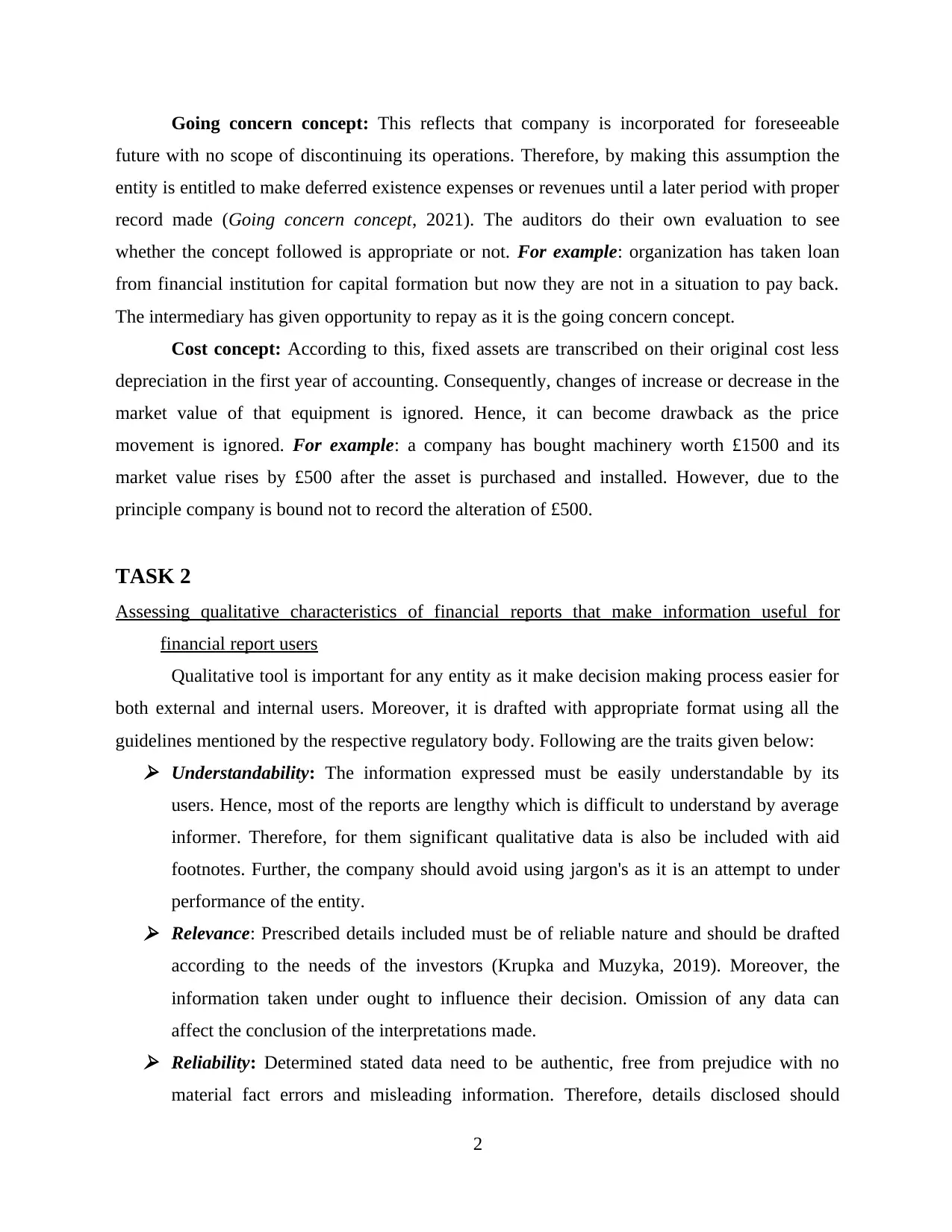
Going concern concept: This reflects that company is incorporated for foreseeable
future with no scope of discontinuing its operations. Therefore, by making this assumption the
entity is entitled to make deferred existence expenses or revenues until a later period with proper
record made (Going concern concept, 2021). The auditors do their own evaluation to see
whether the concept followed is appropriate or not. For example: organization has taken loan
from financial institution for capital formation but now they are not in a situation to pay back.
The intermediary has given opportunity to repay as it is the going concern concept.
Cost concept: According to this, fixed assets are transcribed on their original cost less
depreciation in the first year of accounting. Consequently, changes of increase or decrease in the
market value of that equipment is ignored. Hence, it can become drawback as the price
movement is ignored. For example: a company has bought machinery worth £1500 and its
market value rises by £500 after the asset is purchased and installed. However, due to the
principle company is bound not to record the alteration of £500.
TASK 2
Assessing qualitative characteristics of financial reports that make information useful for
financial report users
Qualitative tool is important for any entity as it make decision making process easier for
both external and internal users. Moreover, it is drafted with appropriate format using all the
guidelines mentioned by the respective regulatory body. Following are the traits given below: Understandability: The information expressed must be easily understandable by its
users. Hence, most of the reports are lengthy which is difficult to understand by average
informer. Therefore, for them significant qualitative data is also be included with aid
footnotes. Further, the company should avoid using jargon's as it is an attempt to under
performance of the entity. Relevance: Prescribed details included must be of reliable nature and should be drafted
according to the needs of the investors (Krupka and Muzyka, 2019). Moreover, the
information taken under ought to influence their decision. Omission of any data can
affect the conclusion of the interpretations made. Reliability: Determined stated data need to be authentic, free from prejudice with no
material fact errors and misleading information. Therefore, details disclosed should
2
future with no scope of discontinuing its operations. Therefore, by making this assumption the
entity is entitled to make deferred existence expenses or revenues until a later period with proper
record made (Going concern concept, 2021). The auditors do their own evaluation to see
whether the concept followed is appropriate or not. For example: organization has taken loan
from financial institution for capital formation but now they are not in a situation to pay back.
The intermediary has given opportunity to repay as it is the going concern concept.
Cost concept: According to this, fixed assets are transcribed on their original cost less
depreciation in the first year of accounting. Consequently, changes of increase or decrease in the
market value of that equipment is ignored. Hence, it can become drawback as the price
movement is ignored. For example: a company has bought machinery worth £1500 and its
market value rises by £500 after the asset is purchased and installed. However, due to the
principle company is bound not to record the alteration of £500.
TASK 2
Assessing qualitative characteristics of financial reports that make information useful for
financial report users
Qualitative tool is important for any entity as it make decision making process easier for
both external and internal users. Moreover, it is drafted with appropriate format using all the
guidelines mentioned by the respective regulatory body. Following are the traits given below: Understandability: The information expressed must be easily understandable by its
users. Hence, most of the reports are lengthy which is difficult to understand by average
informer. Therefore, for them significant qualitative data is also be included with aid
footnotes. Further, the company should avoid using jargon's as it is an attempt to under
performance of the entity. Relevance: Prescribed details included must be of reliable nature and should be drafted
according to the needs of the investors (Krupka and Muzyka, 2019). Moreover, the
information taken under ought to influence their decision. Omission of any data can
affect the conclusion of the interpretations made. Reliability: Determined stated data need to be authentic, free from prejudice with no
material fact errors and misleading information. Therefore, details disclosed should
2
Paraphrase This Document
Need a fresh take? Get an instant paraphrase of this document with our AI Paraphraser
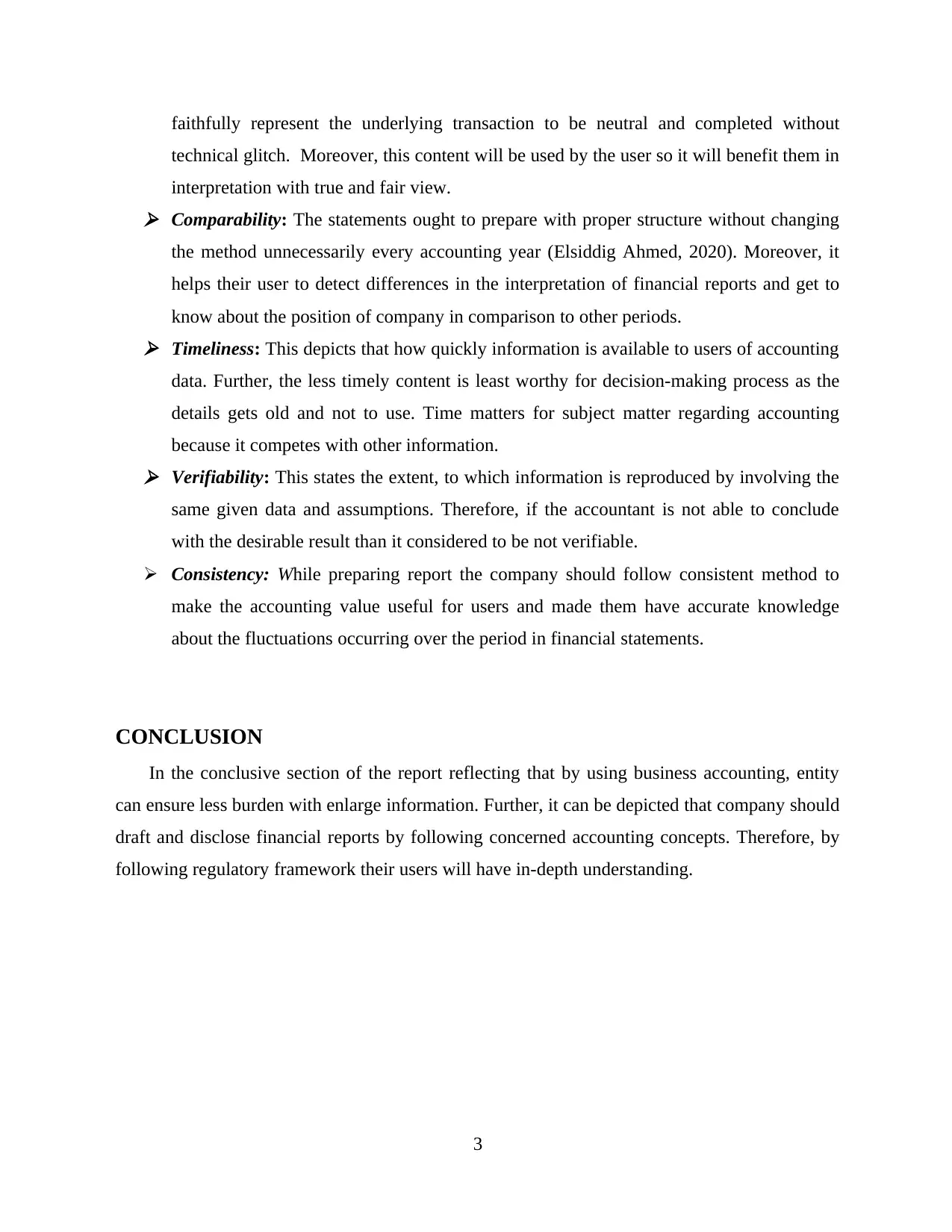
faithfully represent the underlying transaction to be neutral and completed without
technical glitch. Moreover, this content will be used by the user so it will benefit them in
interpretation with true and fair view. Comparability: The statements ought to prepare with proper structure without changing
the method unnecessarily every accounting year (Elsiddig Ahmed, 2020). Moreover, it
helps their user to detect differences in the interpretation of financial reports and get to
know about the position of company in comparison to other periods. Timeliness: This depicts that how quickly information is available to users of accounting
data. Further, the less timely content is least worthy for decision-making process as the
details gets old and not to use. Time matters for subject matter regarding accounting
because it competes with other information. Verifiability: This states the extent, to which information is reproduced by involving the
same given data and assumptions. Therefore, if the accountant is not able to conclude
with the desirable result than it considered to be not verifiable.
Consistency: While preparing report the company should follow consistent method to
make the accounting value useful for users and made them have accurate knowledge
about the fluctuations occurring over the period in financial statements.
CONCLUSION
In the conclusive section of the report reflecting that by using business accounting, entity
can ensure less burden with enlarge information. Further, it can be depicted that company should
draft and disclose financial reports by following concerned accounting concepts. Therefore, by
following regulatory framework their users will have in-depth understanding.
3
technical glitch. Moreover, this content will be used by the user so it will benefit them in
interpretation with true and fair view. Comparability: The statements ought to prepare with proper structure without changing
the method unnecessarily every accounting year (Elsiddig Ahmed, 2020). Moreover, it
helps their user to detect differences in the interpretation of financial reports and get to
know about the position of company in comparison to other periods. Timeliness: This depicts that how quickly information is available to users of accounting
data. Further, the less timely content is least worthy for decision-making process as the
details gets old and not to use. Time matters for subject matter regarding accounting
because it competes with other information. Verifiability: This states the extent, to which information is reproduced by involving the
same given data and assumptions. Therefore, if the accountant is not able to conclude
with the desirable result than it considered to be not verifiable.
Consistency: While preparing report the company should follow consistent method to
make the accounting value useful for users and made them have accurate knowledge
about the fluctuations occurring over the period in financial statements.
CONCLUSION
In the conclusive section of the report reflecting that by using business accounting, entity
can ensure less burden with enlarge information. Further, it can be depicted that company should
draft and disclose financial reports by following concerned accounting concepts. Therefore, by
following regulatory framework their users will have in-depth understanding.
3
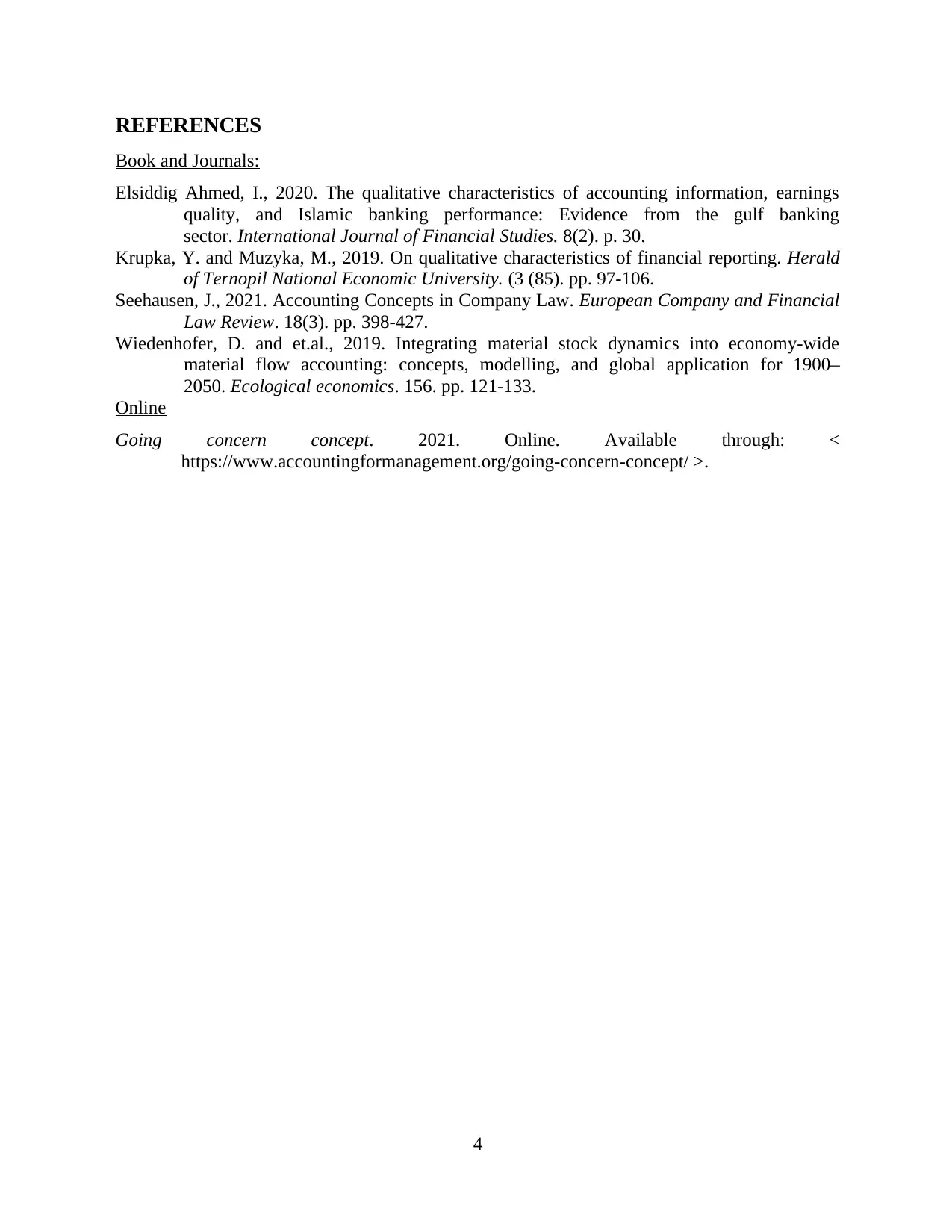
REFERENCES
Book and Journals:
Elsiddig Ahmed, I., 2020. The qualitative characteristics of accounting information, earnings
quality, and Islamic banking performance: Evidence from the gulf banking
sector. International Journal of Financial Studies. 8(2). p. 30.
Krupka, Y. and Muzyka, M., 2019. On qualitative characteristics of financial reporting. Herald
of Ternopil National Economic University. (3 (85). pp. 97-106.
Seehausen, J., 2021. Accounting Concepts in Company Law. European Company and Financial
Law Review. 18(3). pp. 398-427.
Wiedenhofer, D. and et.al., 2019. Integrating material stock dynamics into economy-wide
material flow accounting: concepts, modelling, and global application for 1900–
2050. Ecological economics. 156. pp. 121-133.
Online
Going concern concept. 2021. Online. Available through: <
https://www.accountingformanagement.org/going-concern-concept/ >.
4
Book and Journals:
Elsiddig Ahmed, I., 2020. The qualitative characteristics of accounting information, earnings
quality, and Islamic banking performance: Evidence from the gulf banking
sector. International Journal of Financial Studies. 8(2). p. 30.
Krupka, Y. and Muzyka, M., 2019. On qualitative characteristics of financial reporting. Herald
of Ternopil National Economic University. (3 (85). pp. 97-106.
Seehausen, J., 2021. Accounting Concepts in Company Law. European Company and Financial
Law Review. 18(3). pp. 398-427.
Wiedenhofer, D. and et.al., 2019. Integrating material stock dynamics into economy-wide
material flow accounting: concepts, modelling, and global application for 1900–
2050. Ecological economics. 156. pp. 121-133.
Online
Going concern concept. 2021. Online. Available through: <
https://www.accountingformanagement.org/going-concern-concept/ >.
4
⊘ This is a preview!⊘
Do you want full access?
Subscribe today to unlock all pages.

Trusted by 1+ million students worldwide
1 out of 6
Related Documents
Your All-in-One AI-Powered Toolkit for Academic Success.
+13062052269
info@desklib.com
Available 24*7 on WhatsApp / Email
![[object Object]](/_next/static/media/star-bottom.7253800d.svg)
Unlock your academic potential
Copyright © 2020–2025 A2Z Services. All Rights Reserved. Developed and managed by ZUCOL.



